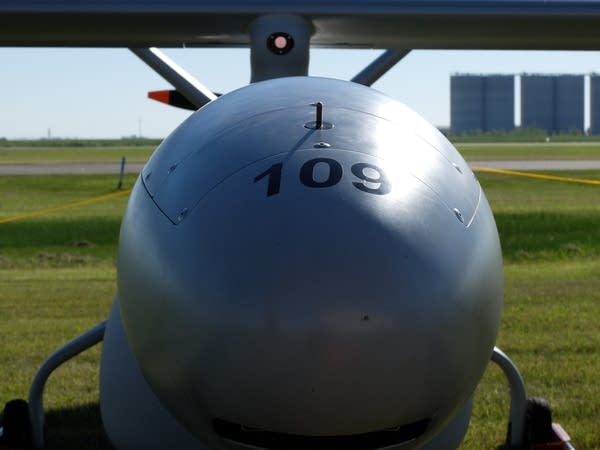A bigger breed of drones is taking to the skies

A bigger breed of unmanned aircraft is taking to the skies for the first time near Fargo this summer in the first test of a large drone for commercial operations.
Much of the buzz around commercial operation of drones is about small drones, with a two- or three-foot wingspan. They typically fly a few hundred feet off the ground. The large commercial drone flying out of Hillsboro Airport 40 miles north of Fargo has a 35-foot wingspan and can fly thousands of feet overhead to gather high resolution images for 20 hours at a time.
The drone is owned by Elbit Systems, an Israeli company. It was designed for military operations, primarily intelligence gathering. But the company wants to expand to commercial operations, according to Leanne Collazzo, vice president of commercial aviation at Elbit Systems of America.
She says the company sees a lot of potential markets, including agriculture, disaster response, monitoring powerlines, pipelines and railroads.
Create a More Connected Minnesota
MPR News is your trusted resource for the news you need. With your support, MPR News brings accessible, courageous journalism and authentic conversation to everyone - free of paywalls and barriers. Your gift makes a difference.
"And we see that as being a very big market," she said. "We're looking in the you know in the billions of dollars in the market overall of how they could use this type of data gathering in precision agriculture as well as some of the other fields we can use it in."
Xcel Energy vice president Laura McCarten thinks this drone could change how electric utilities respond to big storms or floods.
"After storms sometimes we can't get in quickly and assess damage. This technology could allow us to get in at night it could allow us to assess damage where we couldn't normally get a truck," McCarten said. "All that means we can restore power to our customers more quickly, we can do it more safely for our workers and for the public, and we think it'll help us control cost as well."
Xcel says it's contributing $250,000 to this million-dollar research project.
The company is aggressively testing and using both large and small drones in a variety of operations.

Sarah Lovas, who farms and runs an agriculture consulting business in eastern North Dakota, has been using some of that data gathered this summer.
She says images can help her make better decisions. For example, photos can help her fine tune fertilizer applications.
"We can do that right now to a certain extent with precision agriculture and I'm already doing that but having in season imagery and being able to make those decisions in season would make us even even better," she said.
Lovas says she isn't able to say how much the information provided in this trial is worth to her. Cost is a fundamental question if drones are to move beyond potential to commercial success.
And while the FAA has put out rules for small drones, the agency has still not agreed to allow large drones free access to airspace. This drone requires a pilot in a chase plane every time it flies.
That could change later this year. U.S. Sen. John Hoeven, R-N.D., says North Dakota will be the first drone test site allowed to fly drones beyond line of sight, without human eyes on the aircraft at all times.
"That's a huge, huge step because no one else has that and so the companies are coming here because we have things that nobody else has so if they want to develop the R and D and advanced technology they need to come here to do it," Hoeven said.
Rep. Collin Peterson, D-Minn., says he supports the research. But he says the drone industry needs to address safety issues, develop common data standards and convince consumers to use it.
"The question is how long is it going to take, how are we going to standardize it, how are we going to make it affordable. It's going happen, it's a question of when and I think it's going to be awhile," he said.